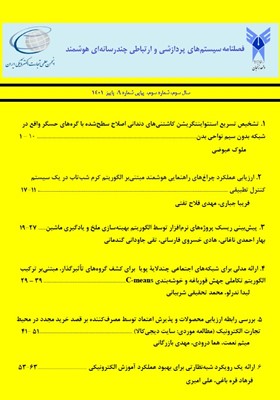ارزیابی عملکرد چراغهای راهنمایی هوشمند مبتنی بر الگوریتم کرم شبتاب در یک سیستم کنترل تطبیقی
محورهای موضوعی : پردازش چند رسانه ای، سیستمهای ارتباطی، سیستمهای هوشمندفریبا جباری 1 , مهدی فلاح تفتی 2 *
1 - دانشجوی کارشناسی ارشد راهوترابری، دانشگاه یزد، یزد، ایران
2 - دانشیار، دانشکده مهندسی عمران، دانشگاه یزد، یزد، ایران
کلید واژه: چراغ راهنمایی زمانثابت, : بهینهسازی چراغهای راهنمایی, الگوریتم کرم شبتاب, چراغ راهنمایی تطبیقی,
چکیده مقاله :
در این پژوهش به بررسی سیستمهای کنترل چراغ راهنمایی تطبیقی جهت کنترل ترافیک تقاطعات پرداخته شده است. برای این منظور از الگوریتم کرم شبتاب جهت توزیع زمان سبز میان رویکردها استفاده شد که به بهینهسازی میزان گذردهی خودروها از تقاطع و طول صف رویکردهای تقاطع میپردازد و در نهایت منجر به بهبود عملکرد ترافیک در تقاطعها میگردد. همچنین جهت بررسی الگوریتم پیشنهادی، به آماربرداری از دو تقاطع شهر یزد و شبیهسازی آنها در نرم افزار شبیهساز AIMSUN پرداخته شد. سپس این تقاطعها برای شرایط موجود کالیبره و اعتبارسنجی شدند. آنگاه الگوریتم مذبور بر آن اعمال گردید و عملکرد آن با سیستم کنترل با زمانبندی ثابت مقایسه گردید. همچنین جهت اطمینان از اختلاف میانگین معنادار شاخصهای ارزیابی طول صف و گذردهی تقاطع بین روش پیشنهادی و روش زمان ثابت، از آزمون t استفاده گردید. نتایج نشان داد روش پیشنهادی که در زمره کنترل تطبیقی چراغ راهنمایی تقاطعها قرار میگیرد دارای عملکرد بهتری نسبت به روش کنترل زمان ثابت در تقاطعهای منفرد است.
IntroductionIn this article, the performance of adaptive traffic signal control systems based on an artificial intelligence technique, namely Firefly Algorithm, for traffic control at urban intersections has been investigated. In order to check the proposed algorithm, the required data were first collected from two intersections in Yazd city. These intersections were then simulated using AIMSUN traffic simulator software and calibrated and validated under existing conditions. In the next step, the adaptive control system based on the proposed Firefly algorithm was developed and then used in simulated intersections and its performance was compared with pre-time control system in terms of intersection traffic capacity and vehicle queue length at the entry approaches. The t-test was used for a more scientific investigation. For this reason SPSS software was used as one of the most widely used statistical software to perform this test.MethodIn order to concurrently optimize vehicle departure volume or throughputat and queue length at the entry approaches of each intersection, the Firefly algorithm was used to to develop a multi-objective adaptive traffic signal control logic and appropriately distribute the effective green time in each cycle between the entry approaches. ResultsThe simulation results indicated a lower average queue length and higher throughput when the proposed adaptive model was compared with pre-time model at both intersections. The t-test results showed that the adaptive traffic signal control method has resulted in a significant lower average queue length than the pre-time time control at one of the intersections with p-value equal to 0.002. However, this improvement was not statistically significant for the other intersection. Moreover, the t-test results on the average flow departure volume measure for both intersections indicated a significant improvement with p-value equal to 0.000. when the proposed adaptive method was compared to the pre- time method.DiscussionAccording to the results, the proposed adaptive model showed better overall performance in the scope of this research than the pre-time control method. The results indicate that the performance of adpative signal controls could be enhanced when artificial intelligence techniques such as Firefly algorithm are used in the control logic and a multi-objective optimization approach is used.
_||_

